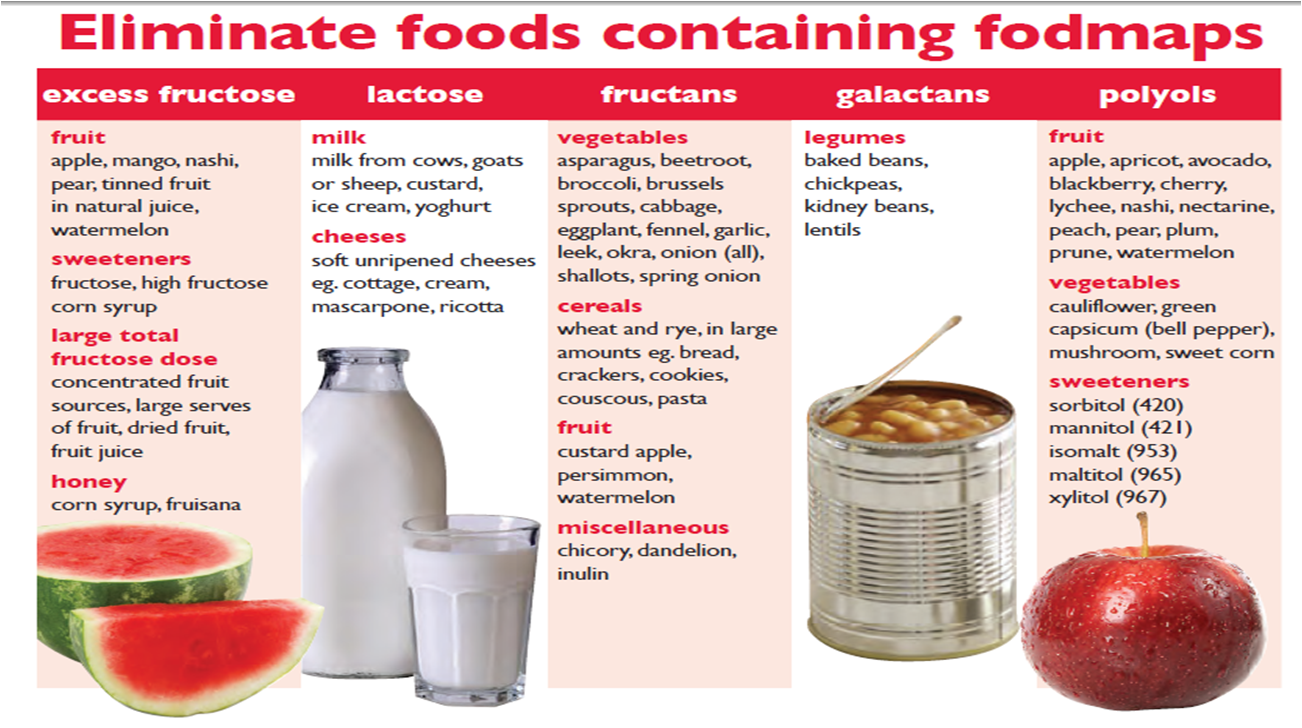FODMAPS are small chains of carbohydrates (sugar) that are not completely absorbed in our intestines. When FODMAPS reaches the small intestine, they move slowly attracting water. When FODMAPS pass through the large intestine, it is fermented by gut bacteria,producing gas as a result. Extra gas & water stretches & expand intestinal wall. It has negative impacts on people suffering from IBS since they have highly sensitive gut. This created pain & discomfort for them. Before we go in detail, it is important to understand the following concepts:
IBS: Irritable Bowel Syndrome is characterised by chronic symptoms which includes lower abdominal pain, discomfort, bloating, wind & altered bowel habit
Fermentation: Process by which gut bacteria ferment undigested carbohydrates to produce gases.
Oligosaccharides:Fructans food in foods such as wheat, rye, onion, garlic & legumes.
Disaccharides: Lactose found in dairy products such as milk, cheese & yoghurts.
Monosaccharides: Fructose found on Honey, apples, Fructose corn syrups.
Polyols: Found in some fruits & vegetables & used as artificial sweeteners.
FODMAPS are found in a wide range of foods such as fruits, vegetables, breads, cereals, nuts, legumes & confectionary.It is difficult to assess the amount of FODMAPS in your food. Most people consume foods with high FODMAPS without any issue. However, those suffering from IBS can have problems of motility- speed at which different food items pass through intestines & sensitive gut wall.
Who should follow the FODMAP diet?
FODMAP diets are for folks who are medically diagnosed with IBS. If you have symptoms similar to IBP such as inflammation, coeliac disease & bowel cancer do not self diagnose with IBP. Instead consult a doctor who will evaluate your situation by undergoing some tests.
Having a low FODMAP diet offers following benefits specifically for people suffering from IBS:
- Reduce pain & discomfort
- Reduce bloating & distension.
- Improve bowel movement.
These changes are usually seen within 4 to 6 weeks of adopting FODMAP diet.
The following are perfect options to replace high FODMAP with low FODMAP diet.
| Food Items | High FODMAP foods | Low FODMAP alternatives |
| Vegetables | Artichoke, asparagus, cauliflower, garlic, green peas, mushrooms, onion, | Aubergine/eggplant, beans (green), capsicum (bell pepper), carrot, cucumber, lettuce, tomato, zucchini |
| Fruits | Apples, apple juice, cherries, dried fruit, mango, nectarines, peaches, pears, plums, | Cantaloupe, grapes, kiwi fruit (green), mandarin, orange, pineapple, |
| Dairy | Cow’s milk, custard, evaporated milk, ice cream, soy milk sweetened condensed milk, yoghurt | Almond milk, brie/camembert cheese, feta cheese, hard cheeses, lactose-free milk, |
| Protein sources | Most legumes/pulses, some marinated meats/poultry/seafood, some processed meats | Eggs, firm tofu, plain cooked meats/poultry/seafood, |
| Breads & cereals | Wheat/rye/barley based breads, breakfast cereals, biscuits and snack products | Corn flakes, oats, quinoa flakes, quinoa/rice/corn pasta, rice cakes (plain), wheat/rye/barley free breads |
| Sugars, sweeteners & confectionery | High fructose corn syrup, honey, sugar free confectionery | Dark chocolate, maple syrup, rice malt syrup, |
| Nuts & seeds | Cashews, pistachios | peanuts, pumpkin seeds/pepitas, walnuts |
